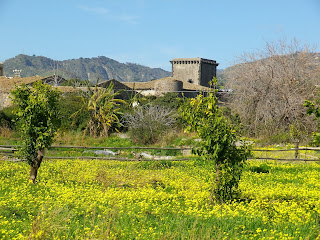Catania is the town where I spent most of my time. Although not as large as the capitol of Palermo, it was quite busy. I was fortunate to be around for the festival of Saint Agatha from February 3rd to the 5th. Hundreds of thousands of people come to celebrate the life of the saint for three straight days. Agatha is the patron saint of Catania born circa 231 and died circa 251 AD. She is buried inside the cathedral in Catania (shown below).
Catania is a unique place in that it has a busy port, many restaurants and is a place where fishermen and farmers bring their goods to outdoor markets where residents come to shop. It also had areas which seemed a bit upscale where they had fine jewelry stores and expensive clothing for sale. The public transportation was quite sophisticated although I didn't go for a ride and amidst all this, there is a church on every corner and ancient structures still standing that date back to Before Christ.
The highlight of Catania for me was the Teatro Romano. It was less than a mile walk from my hotel so I figured I'd like to check it out since I really enjoyed the theatre in Taormina. Wow I am so glad I went. There were only a few people here when I walked in and soon I was the only one in the entire place! Well me and the cats who live there. Another moment where I felt it was just me, God, the ancient spirits and the cats. :)
I really could spend hours just sitting here because I can't believe something could be so old and that fascinates me. I feel special just touching the stone and being able to soak it all in and wonder what life was like 2,000 years ago. Yes this trip did bring the nerdy side out of me!
Catania is a unique place in that it has a busy port, many restaurants and is a place where fishermen and farmers bring their goods to outdoor markets where residents come to shop. It also had areas which seemed a bit upscale where they had fine jewelry stores and expensive clothing for sale. The public transportation was quite sophisticated although I didn't go for a ride and amidst all this, there is a church on every corner and ancient structures still standing that date back to Before Christ.
The highlight of Catania for me was the Teatro Romano. It was less than a mile walk from my hotel so I figured I'd like to check it out since I really enjoyed the theatre in Taormina. Wow I am so glad I went. There were only a few people here when I walked in and soon I was the only one in the entire place! Well me and the cats who live there. Another moment where I felt it was just me, God, the ancient spirits and the cats. :)
I really could spend hours just sitting here because I can't believe something could be so old and that fascinates me. I feel special just touching the stone and being able to soak it all in and wonder what life was like 2,000 years ago. Yes this trip did bring the nerdy side out of me!




































